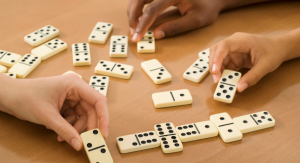The first parent-teacher conferences of the year are here! In these initial meetings, students strengths are highlighted and goals are identified. Math learning is discussed. However, do you know much about how your child should learn math? What if your child has already determined they are not a “math kid”? Even though it feels overwhelming, there are many ways for parents to reinforce math.

The myth of not being a math person is an old one, one that plenty of research debunks. This is particularly true for our children’s growing brains.
We often see children through a lens of strengths and weaknesses, which frequently correlate with interests and disinterests. When our kids have free time, we notice what they gravitate towards: building toys such as legos, imaginary play, or visual skills like drawing. We tend to sign them up for after school enrichment activities they ask to engage in. As a result, we reinforce their interests and therefore, their strengths.
The idea that strengths are innately fixed abilities, meaning students are “math kids” or “language kids”, is incredibly dated. Today, we know more about neuroplasticity. Neuroplasticity is the brain’s ability to reorganize itself by creating new neural connections. Brain research also shows how our adult brains are capable of higher learning throughout one’s lifetime.
 Research on neuroplasticity highlights the critical importance of HOW we teach children. In this case, rethinking how we approach teaching math. In the 21st century, memorizing multiplication facts at rapid speed needs to be deemed archaic. Also, using fingers to count should be reinforced!
Research on neuroplasticity highlights the critical importance of HOW we teach children. In this case, rethinking how we approach teaching math. In the 21st century, memorizing multiplication facts at rapid speed needs to be deemed archaic. Also, using fingers to count should be reinforced!
Experts in the area of teaching math in today’s world identify 6 ways for parents to reinforce math:
- Encourage puzzles and games, and anything with dice! Children enjoy math when it’s interactive and fun, and reinforcing number sense is the goal. We love this game for younger children, and the website mathforlove.
- Always focus on the logic of your child’s thinking when they approach math. If an answer is incorrect, ask them to walk you through their steps/thoughts. Become familiar with “math talks”!
- Encourage number sense. Number sense is flexibility when working with numbers. For example, instead of adding 36 + 44, manipulate the 4 and 6 to 10, and add 30 + 50. Number sense is ultimately what separates high and low achievers.

- NEVER associate math with speed. The result is anxiety. Avoid flashcards and use visual activities like these to reinforce facts.
- Keep an open mind about math, regardless of your personal experience. Research has shown, that when a math dislike is shared with children, math anxiety increases.
- Encourage and reinforce a “growth mindset”. A growth mindset is the concept of having unlimited potential by working hard and making mistakes. Telling a child they are “smart” after an accomplishment actually reinforces a fixed mindset, and the expectation becomes similar to that of perfection. Children labeled as “gifted” create self expectations that do not allow for mistakes, ultimately limiting self exploration and increased personal struggle. Learn more about growth mindsets from Stanford psychologist Carol Dwek.










